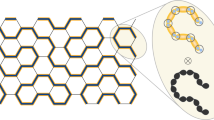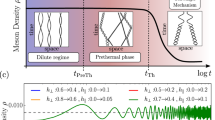Abstract
The concept of confinement states that in certain systems the constituent particles are bound together by an interaction for which the strength increases with increasing particle separation. One of the consequences of this is that these individual particles cannot be observed directly. The most famous example of confinement is found in particle physics where baryons and mesons are produced by the confinement of quarks. However, similar phenomena can occur in condensed-matter physics systems such as spin ladders that consist of two spin-1/2 antiferromagnetic chains coupled together by spin exchange interactions. Excitations of individual chains (spinons) carrying spin S=1/2, are confined by even an infinitesimal interchain coupling. Most ladders studied so far cannot illustrate this process because the large strength of their interchain coupling suppresses the spinon excitations at all energy scales. Here we present neutron scattering experiments for a weakly coupled ladder material. At high energies the behaviour of this system approaches that of individual chains, but at low energies it is dominated by the integral spin excitations of strongly coupled chains.
This is a preview of subscription content, access via your institution
Access options
Subscribe to this journal
Receive 12 print issues and online access
$209.00 per year
only $17.42 per issue
Buy this article
- Purchase on Springer Link
- Instant access to full article PDF
Prices may be subject to local taxes which are calculated during checkout




Similar content being viewed by others
References
Greiner, W. & Schafer, A. Quantum Chromodynamics (Springer, 1994).
Gell-Mann, M. The Quark and the Jaguar (Owl Books, 1995).
Fonseca, P. & Zamolodchikov, A. J. Stat. Phys. 110, 527–590 (2003).
Delfino, G. & Mussardo, G. Nonintegrable quantum field theories as perturbations of certain integrable models. Nucl. Phys. B 473, 469–508 (1996).
Delfino, G. & Mussardo, G. Nonintegrable aspects of the multifrequency Sine–Gordon model. Nucl. Phys. B 516, 675–703 (1998).
Shelton, D. G., Nersesyan, A. A. & Tsvelik, A. M. Antiferromagnetic spin ladders: Crossover between spin S=1/2 and S=1 chains. Phys. Rev. B 53, 8521–8532 (1996).
Greiter, M. Fictitious flux confinement: Magnetic pairing in coupled spin chains or planes. Phys. Rev. B 66, 054505 (2002).
Notbohm, S. et al. One- and two-triplon spectra of a cuprate ladder. Phys. Rev. Lett. 98, 027403 (2007).
Schmidt, K. P. & Uhrig, G. S. Spectral properties of magnetic excitations in cuprate two-leg ladder systems. Mod. Phys. Lett. B 19, 1179–1205 (2005).
Windt, M. et al. Observation of two-magnon bound states in the two-leg ladders of (Ca,La)14Cu24O41 . Phys. Rev. Lett. 87, 127002 (2001).
Nersesyan, A. A. & Tsvelik, A. M. One-dimensional spin liquid without magnon excitations. Phys. Rev. Lett. 78, 3939–3942 (1997).
Witten, E. Non-abelian bosonization in 2 dimensions. Commun. Math. Phys. 92, 455–472 (1984).
Novikov, S. P. Multivalued functions and functionals—the analog of Morse-theory. Dokl. Akad. Nauk SSSR 260, 31–35 (1981).
Moore, G. & Read, N. Nonabelions in fractional quantum Hall effect. Nucl. Phys. B 360, 362–396 (1991).
Greiter, M., Wen, X.-G. & Wilczek, F. Paired Hall states. Nucl. Phys. B 374, 567–614 (1992).
Takhtajan, L. A. The picture of low-lying excitations in the isotropic Heisenberg chain of arbitrary spins. Phys. Lett. A 87, 479–482 (1982).
Babujian, H. M. Exact solution of the isotropic Heisenberg chain with arbitrary spins: Thermodynamics of the model. Nucl. Phys. B 215, 317–336 (1983).
Goiran, M. et al. High-field ESR studies of the quantum spin magnet CaCu2O3 . New J. Phys. 8, 74 (2006).
Calzado, C. J., de Graaf, C., Bordas, E., Caballol, R. & Malrieu, J.-P. Four-spin cyclic exchange in spin ladder cuprates. Phys. Rev. B 67, 132409 (2003).
Bordas, E., de Graaf, C., Caballol, R. & Calzado, C. J. Electronic structure of CaCu2O3: Spin ladder versus one-dimensional spin chain. Phys. Rev. B 71, 045108 (2005).
Wolf, M. et al. Magnetism in pseudo-two-leg ladder compound CaCu2O3 . J. Magn. Magn. Mater. 290, 314–317 (2005).
Kiryukhin, V. et al. Magnetic properties of the S=1/2 quasi-one-dimensional antiferromagnet CaCu2O3 . Phys. Rev. B 63, 144418 (2001).
Knizhnik, V. G. & Zamolodchikov, A. B. Current algebra and Wess–Zumino model in two dimensions. Nucl. Phys. B 247, 83–103 (1984).
Schulz, H. J. Phase diagrams and correlation exponents of spin chains with arbitrary spin quantum number. Phys. Rev. B 34, 6372–6385 (1986).
Lake, B., Tennant, D. A., Frost, C. D. & Nagler, S. E. Quantum criticality and universal scaling of a quantum antiferromagnet. Nature Mater. 4, 329–334 (2005).
Caux, J.-S. & Hagemans, R. The four-spinon dynamical structure factor of the Heisenberg chain. J. Stat. Mech. P12013 (2006).
Sekar, C., Krabbes, G. & Teresiak, A. Effect of Zn-doping on crystal growth structure of the pseudo-ladder compound. J. Cryst. Growth 273, 403–411 (2005).
Acknowledgements
We are grateful to A. A. Nersesyan, F. H. L. Essler, J.-S. Caux, R. Coldea and T. M. Rice for interesting discussions. E. M. Wheeler helped with the initial data analysis. The work was supported by the US DOE under contract number DE-AC02-98 CH 10886 (A.M.T.). A.M.T. also thanks the Galileo Galilei Institute for Theoretical Physics for kind hospitality and INFN for partial support during the completion of this work.
Author information
Authors and Affiliations
Contributions
C.S., G.K. and B.B. grew the crystals. B.L., S.N., D.A.T., T.G.P. and M.R. did the experiments. Data analysis was carried out by B.L., theory was done by A.M.T. and the article was written by A.M.T. and B.L.
Corresponding authors
Rights and permissions
About this article
Cite this article
Lake, B., Tsvelik, A., Notbohm, S. et al. Confinement of fractional quantum number particles in a condensed-matter system. Nature Phys 6, 50–55 (2010). https://doi.org/10.1038/nphys1462
Received:
Accepted:
Published:
Issue Date:
DOI: https://doi.org/10.1038/nphys1462
This article is cited by
-
Soliton confinement in a quantum circuit
Nature Communications (2023)
-
Emergent many-body composite excitations of interacting spin-1/2 trimers
Nature Communications (2022)
-
Quadrupolar magnetic excitations in an isotropic spin-1 antiferromagnet
Nature Communications (2022)
-
Prethermalization in one-dimensional quantum many-body systems with confinement
Nature Communications (2022)
-
Three-body bound states in antiferromagnetic spin ladders
Communications Physics (2022)



